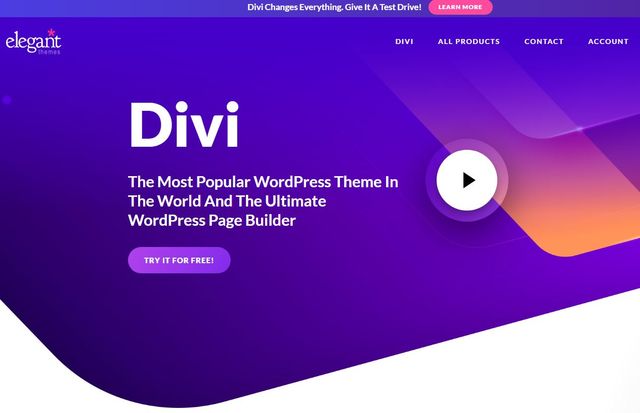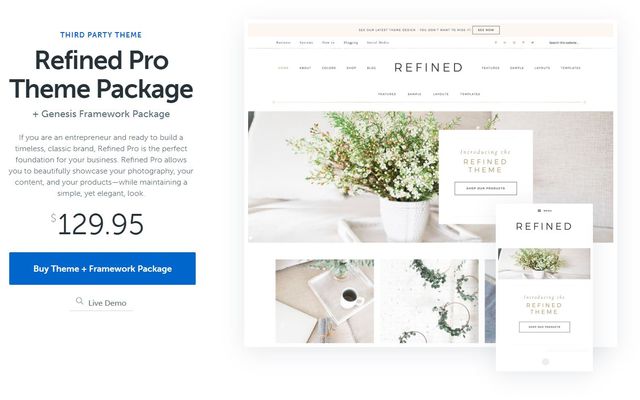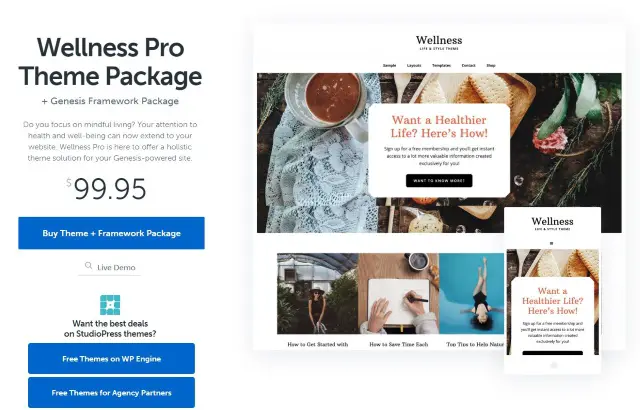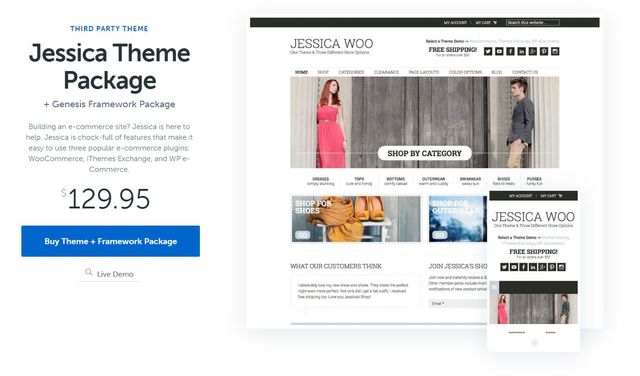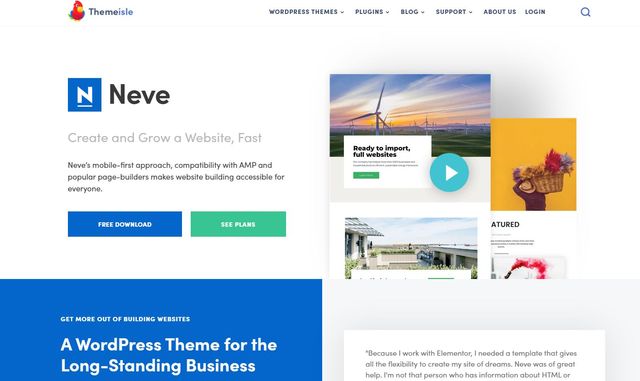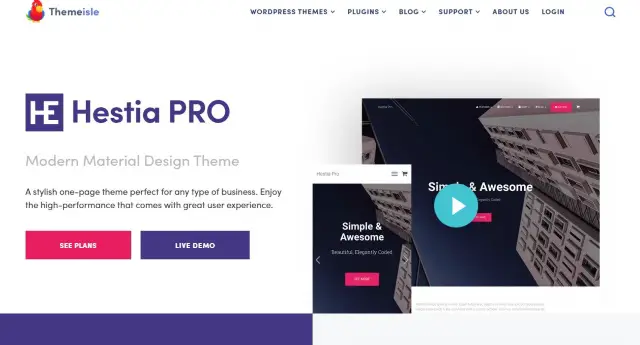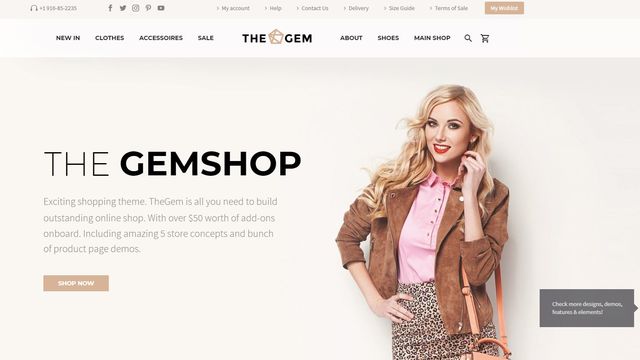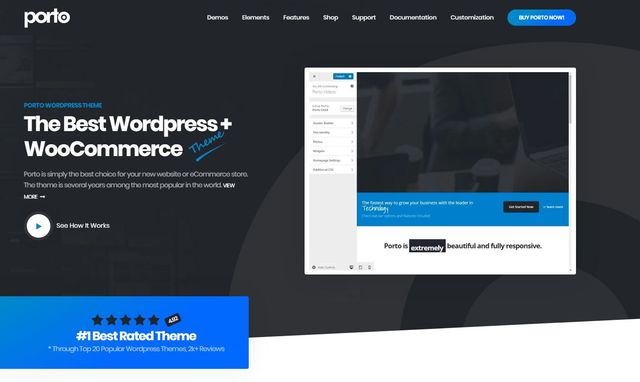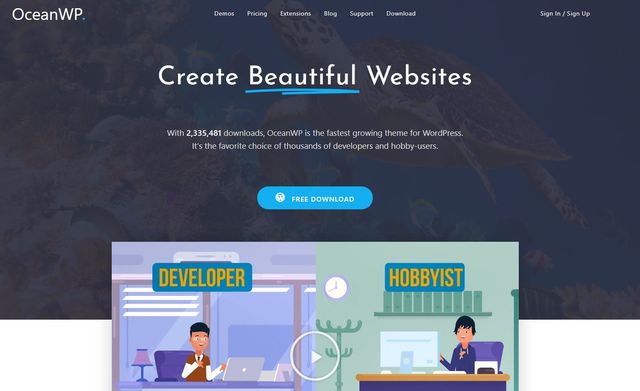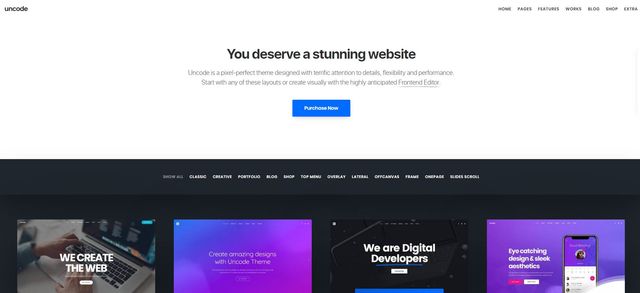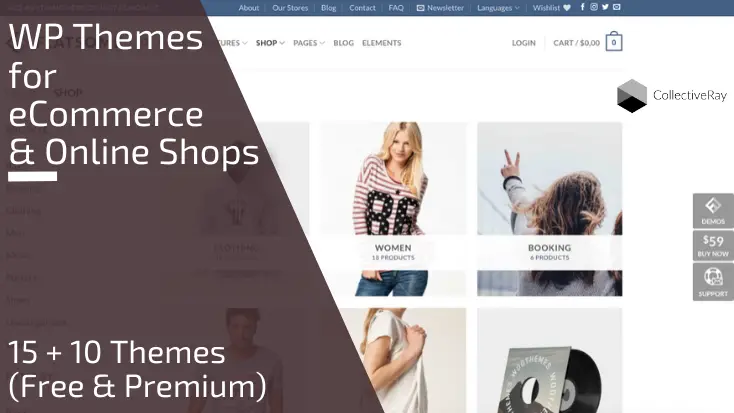
Selling products online has never been easier. With the incredible selection of WordPress eCommerce themes available, you can just pick up a theme, set it up and you're up and running within a few hours, or days at most!
Over the last few years, the popularity of eCommerce and platforms such as WooCommerce and Shopify has grown to a level nobody could have predicted.
With the growing demand for online shopping, businesses of all shapes and sizes are moving towards an eCommerce platform to complement or even replace a brick and mortar store.
In this article, we are going to discuss the 25 best WordPress eCommerce themes that have been specifically designed for online stores.
Some of them are premium themes that have been carefully selected, tried and tested by us before being recommended.
Others are free WordPress eCommerce themes. Again, we have tried them all to ensure they are good enough to be endorsed by us and used by you
eCommerce in numbers
The size and scope of eCommerce is massive. To illustrate just how lucrative the industry is, here are some statistics to demonstrate our point.
- It’s estimated that there will be over 3 billion global digital buyers in 2023.
- In 2025, eCommerce sales are expected to be 25% of retail sales worldwide.
- The number one reason people shop online is that they’re able to shop at all hours of the day.
- Mobile eCommerce is expected to account for 67.2% of digital sales.
- In the last six months, 83% of US consumers have made a purchase on Amazon.
- On average, two in five US consumers (41%) receive one to two packages from Amazon per week. That number jumps to half (50%) for consumers ages 18-25, and 57% for consumers ages 26-35.
The ten largest markets for eCommerce are:
- China: $672 billion
- USA: $340 billion
- United Kingdom: $99 billion
- Japan: $79 billion
- Germany: $73 billion
- France: $43 billion
- South Korea: $37 billion
- Canada: $30 billion
- Russia: $20 billion
- Brazil: $19 billion
As you can clearly see, now is an excellent time to launch your own online store!
In the United States alone, more than 60% of people prefer to buy goods through e-Commerce platforms.
WordPress as an eCommerce platform
If you want to take your offline business online, you need to ensure that you choose the right eCommerce platform for your own business.
There are a number to choose from, WordPress, Joomla, Drupal, WooCommerce, Shopify (you can read more about Shopify here) and others and we suggest researching each of them before committing to one.
We recommend WordPress for a lot of things including eCommerce. It’s a very stable system, is free to use, works on most web hosting plans and is almost infinitely flexible.
With eCommerce addons and an eCommerce template, you could genuinely have your online shop up and running in a matter of hours!
We also recommend the WooCommerce plugin for WordPress. Launched in 2011, this plugin has transformed business on the internet.
WooCommerce is a free plugin that has made eCommerce approachable even for beginners. That’s why we like it so much.
And of course, there are plenty of responsive themes you can choose from for your eCommerce site.
Best WordPress eCommerce themes 2024
So, without further ado, let’s see those free and premium eCommerce themes!
1. Divi
Divi (as you can see in our review) has to be one of the best WordPress themes around. We have spent dozens of hours with it and like almost everything about it.
The themes look professional and have a wide range of templates for all kinds of stores. Each is customizable to your own needs too.
Divi isn’t just a WordPress theme, it’s a complete page building system with its own layout configurator.
It’s easy to load a premade template but it is equally straightforward to build your own or customize one of those templates to your own unique needs.
Benefits of Divi WordPress theme include:
- Self-contained theme with page builder.
- A selection of plugins adding further functionality if required.
- Range of great-looking themes.
- Support for WooCommerce, Mailchimp, ActiveCampaign and other plugins.
- Responsive and translation-ready.
Click here to get Divi for 10% OFF until April 2024
Read More: Divi vs Avada - which one is best? (Hint: it's Divi)
2. Astra
Astra is another favourite of ours at CollectiveRay, (check out our Astra theme reviews). It’s fast, works exceptionally well and has themes that would work perfectly with WooCommerce or any eCommerce plugin you decide to use.
The designs are top class, pricing is reasonable and support is pretty good too.
A significant highlight of Astra is its lightweight. Pages load quickly, the theme can be further optimised for speed and SEO and the use of JavaScript rather than jQuery means you can streamline page loading as far as possible.
Features of the Astra WordPress theme include:
- Compatible with WooCommerce, LearnDash, Divi, Elementor or other page builders.
- Huge range of font and colour combinations.
- Wide selection of professional standard templates.
- Designed to be light and load quickly.
- Responsive and accessible.
Download Astra Free or Pro now
3. Avada
Avada by ThemeFusion is another top performer ideal for WordPress eCommerce.
Like Divi, Avada isn’t just a theme, it’s a fully-fledged site and page builder with its own tools, drag and drop functionality, layout creator and powerful tools for delivering an exceptional website.
There is something of a learning curve but that is the same for all these builders. Avada offers clean code, fast page loading, a flexible approach to site design and the ability to deliver a professional looking eCommerce website with the minimum of fuss.
Avada eCommerce WordPress theme delivers:
- Complete WordPress theme and theme builder.
- Compatible with WooCommerce and other leading plugins.
- Array of top quality premade templates.
- Over 70-page elements.
- Responsive and proven to work on any device.
- Extensive theme options.
Check out the live preview of Avada with eCommerce ready-site
4. Refined Pro
Refined Pro is an eCommerce theme from Studiopress. The developers have dozens of themes to choose from but this stands out.
It is elegant, clean, makes great use of white space and image blocks and has a very elegant feel. It could be ideal for many types of online store.
Refined Pro uses the Genesis Framework which is another mark in its favour.
The theme is responsive, includes a page builder and customizer, uses HTML5 and has dozens of page elements you can use across your site as required. Refined Pro has already been built with WooCommerce in mind too!
Refined Pro WordPress theme features:
- Cohesive theme customizer and theme options
- Uses the Genesis Framework.
- Fully responsive and accessible.
- Supports WooCommerce.
- Fast loading, clean code.
Check out the demo of Refined Pro
5. Wellness Pro
Wellness Pro is another theme that uses the Genesis Framework. It’s another clean design but more image-heavy than Refined Pro. It would suit more dynamic online stores selling a wide range of products.
The pages are balanced, the theme is pre-designed for WooCommerce and can be used as-is or customized.
Wellness Pro is fully responsive and accessible WordPress theme, is translation ready, uses HTML5, has a wide range of widgets and widget areas you can use and multiple layout options.
While the standard theme is excellent, you can also customize it to your own needs with ease.
Wellness Pro highlights include:
- Uses the Genesis Framework.
- Theme options and customizable.
- WooCommerce compatible.
- Responsive and accessible.
- Fast loading with clean code.
Get Wellness at the best price
6. Jessica
Jessica is our final offering for a theme for the Genesis Framework. It’s a different option from Refined Pro and Wellness Pro and offers a genuinely flexible online store.
It uses the same flexible builder as the others but is a much cleaner and sharper design. A design that could lend itself to many store types.
Jessica is also very clean, uses HTML5, loads quickly, is responsive and accessible, able to be translated quickly, is already built around WooCommerce, has a range of widgets and widget areas to enhance the user experience and includes everything you need to launch a store.
Jessica eCommerce WordPress theme offers:
- Clean, modern page design.
- Uses the Genesis Framework.
- Various theme options.
- Built around WooCommerce.
- Fully responsive and accessible.
- Full support with updates for a year.
Click for the lowest price on Jessica in April 2024
7. Neve
Neve is another firm favourite of us here at CollectiveRay. As an eCommerce template, it stands out from the crowd for offering almost unlimited customization options, regular updates, clean code, full support, fast page load speed, a whole host of tools and plugins and everything you could need to set up your eCommerce empire.
Neve is available with a range of clean, attractive templates that genuinely look like professional retail outlets.
In fact, many retailers use Neve as the backbone to the eCommerce side of their business so you’re in good hands!
The Neve WordPress theme offers:
- Elementor and Divi compatibility.
- Works with WooCommerce and other plugins.
- Wide range of excellent templates.
- Fast page load speeds and lightweight pages.
- Full support and great documentation.
- Responsive and accessible.
8. Hestia
Hestia is another regular in our recommended WordPress template posts and for good reason. Like Neve, it’s another top-flight product from Themeisle.
This particular design is flat and uses the modern material design for a completely different look and feel to Neve while offering the same benefits.
Hestia comes complete with a range of premade templates and is built around WooCommerce. It can be modified and personalized with the included page builder and you can change everything from the header to the footer and everything in-between.
It is a truly flexible yet powerful WordPress theme.
The Hestia Pro WordPress theme includes:
- Elementor and Divi compatibility.
- Built around WooCommerce.
- Wide range of template customization options.
- Fast page load speeds and lightweight pages.
- Full support and superb documentation.
- Responsive and accessible.
Click here for the lowest price on Hestia Pro in April 2024
9. Osteria
Osteria from Pixelgrade is a food service template that could work for food deliveries, online food sales, restaurants, cafes or takeaways.
This WooCommerce theme is a very accomplished theme that looks modern, makes great use of imagery and fonts, uses content blocks well and makes an excellent first impression.
This is a parallax template that could work well for many food-oriented businesses and has a specific menu widget to create professional-looking menus, customizable page options so you can make it your own.
It is also fully responsive, translation ready and has accessibility support.
Highlights of Osteria eCommerce WordPress theme include:
- Comes with WooCommerce already integrated.
- Very usable menu creator.
- Clean modern look with parallax scrolling.
- Online booking or reservation widget included.
- Designed for fast loading and SEO.
- Fully responsive and accessible.
Visit the Beautiful Osteria demo
10. TheGem
TheGem is a ThemeForest template for WordPress that really does stand out. It’s a top-quality eCommerce theme / WooCommerce theme ideal for a range of clothing, jewellery and accessory stores.
You could also customize it to other uses too but the example shows just how good it looks for those niches.
The template is clean, loads quickly, uses imagery and white space very well and includes all those page elements you would expect to see on a retailer’s website.
It uses the WPBakery page builder so you can customize every element. The theme also includes WooCommerce compatibility and a range of premade pages.
TheGem eCommerce WordPress theme offers:
- Clean, modern eCommerce template ready for use.
- Compatibility with WooCommerce and other plugins.
- WPML compatible for translation.
- Responsive and accessible.
- Comes with a range of layout options.
11. GeneratePress
GeneratePress is another ideal option for your WordPress eCommerce website.
It works with Elementor and Beaver Builder page builders, offers a wide range of premade templates, including some eCommerce ones, has a free and a premium option and can be customized almost infinitely.
GeneratePress has been designed to be lightweight and load quickly while also being safe and secure. It has no dependencies either as it uses JavaScript, which also helps loading and SEO.
It is also fully responsive, accessible and translation ready for maximum reach.
GeneratePress delivers:
- Smooth stable eCommerce template.
- WooCommerce compatible.
- Compatible with Elementor page builder and Beaver Builder.
- Range of clean, modern themes ready for use.
- Fully responsive and accessible.
Check out the demo of the fast GeneratePress theme
12. Flatsome
Flatsome is another great eCommerce WordPress template from ThemeForest. It’s a very modern store theme with a range of premade templates covering a range of product types.
The theme also includes a page builder so you can customize or create your own depending on your needs.
The theme is a great option as a WooCommerce theme, including fully customizable Google Fonts, and other plugins.
It also includes full customization options, the ability to remove jQuery from the template, TikTok integration, a neat page builder and full support.
Flatsome eCommerce WordPress theme offers:
- A huge selection of modern eCommerce templates.
- Full compatibility with the latest version of WooCommerce.
- Built-in page builder with the ability to customize everything.
- Comes with Flatsome Studio page, design and element library.
- Responsive, accessible and translation-ready.
- Fully customizable
Visit the Flatsome Llve preview on Themeforest
13. Porto
Porto is a very modern eCommerce theme for WordPress. It comes with over 900 premade templates, uses the WPBakery page builder, has been designed from the ground up to work with WooCommerce and has also been built to use as few resources as possible to load quickly regardless of the web host.
Porto also emphasizes page load speed and has been built to achieve high scores on Page Speed Insights while still delivering the experience customers expect.
Regular updates ensures Porto always uses the latest code and is as secure as possible and full support from the developer should answer any questions you might have.
Porto has:
- WPBakery page builder included for easy customization.
- Designed around WooCommerce, ideal for online stores.
- Flexible, very customizable templates.
- Designed for page load speed and clean code.
- Fully responsive, accessible and translation-ready.
14. OceanWP
OceanWP is a WordPress theme we have spent a lot of time with here at CollectiveRay. It’s an accomplished theme with a free and a premium version.
You will need to pay to use it with eCommerce but pricing is very reasonable. The themes are polished, clean and modern and offer a wide range of looks for different store types.
OceanWP uses the Elementor page builder, is fully compatible with WooCommerce, offers full customizability, has been designed to load very quickly and has support for pop-ups to minimize abandoned carts, highlight special offers and all manner of features.
OceanWP offers:
- A selection of modern eCommerce templates.
- Elementor page builder for ease of use.
- WooCommerce compatible so you can be up and running quickly.
- Lots of elements and page options for personalisation, fully customizable.
- Designed to load quickly on any device.
Get OceanWP at the best price in April 2024
15. Uncode
Uncode is an excellent premium WordPress eCommerce template.
It’s a very modern theme with dozens of templates that could be suitable for the widest range of store types.
Uncode offers full control of every page element and includes dozens of widgets, boxes, page elements, fonts, colours and more to create your very own online store.
You can use one of the included templates and be up and running quickly, customize your own or build one from scratch, whatever works for you.
Uncode is:
- Full of modern, attractive page templates.
- Easy to build and customize your pages to your own needs.
- Fully compatible with WooCommerce and other leading plugins.
- Fast to load and SEO friendly.
- Responsive and accessible.
Check out the live preview of Uncode
16. Modern Store WordPress Theme

With the Modern Store WordPress theme you can create a clean and user-friendly eCommerce website today.
This free theme has complete WooCommerce support and also includes some advanced integrations.
For example, Modern Store features a product search bar at the top of the site that shoppers can use to quickly find products on your site. The category dropdown can help narrow their search, and it works just as well on mobile devices as well as desktops and laptops.
Modern Store also includes user account and cart buttons in the header, so you don't need to install any new plugins for these features.
When it comes to customization, the Modern Store theme includes a wide assortment of tools.
In the Live Customizer, you can edit every detail of the promo that displays at the top of the site. Swap out the call-to-action and background image to promote any deal on your site. The homepage also has a dedicated builder which lets you enable/disable different sections like On-Sale Products, Featured Categories, and Highest-Rated Products.
Overall, it's a very flexible and easy to use WordPress theme, and it's free to use as long as you'd like.
17. XStore

Xstore is an elegant WordPress eCommerce theme that lets you customize different elements of your shop with ease. There are more than 50 shop designs available which you can install with just a few clicks.
Whether you need to set up an online bookshop, finance company or a clothing store, this theme can help. Free themes don’t usually have the bells and whistles of premium but XStore punches way above its weight in that regard.
Features of XStore eCommerce WordPress theme include:
- Fully responsive runs perfectly on every mobile device.
- Requires modest WordPress knowledge to customize.
- Compatible with all popular browsers, including Chrome, Mozilla and Safari.
- This multipurpose template can be used for different business niches.
18. Vantage

Vantage is another fully responsive, multi-purpose WordPress eCommerce theme that can fit any business niche. Vantage is popular for its integration with plugins such as meta slider, page builder, WooCommerce and others.
It is retina-ready and offers free as well as premium support through support forums. Additionally, the theme lets you customize the different aspects of your website such as hover effects, content colour, site title, page title, links, widgets and every element you see on the page.
The reliability of this popular item can be judged by it having over 1 million downloads. A huge milestone that only the very best WordPress themes can boast.
Features of Vantage:
- Different layout options.
- Meta slider integration.
- Retina-ready.
- Supports the CSS editor.
- Supports Google fonts.
19. Corporate Plus

Want to set up a fully functional single page ready storefront? You can’t find a better design than Corporate Plus. This professional-looking design comes with a distinctive about section, contact section, parallax section, blog section, and slider section. All combine to deliver a fully customizable eCommerce template for new stores of all types.
The theme offers a wide range of widgets that you can use to add more features and functionality to your website.
Highlights of Corporate Plus:
- Colourful theme with modern design.
- Multipurpose theme that could work for online stores.
- Very well-reviewed.
- Flexible page elements.
- Lots of customization options.
20. eStore
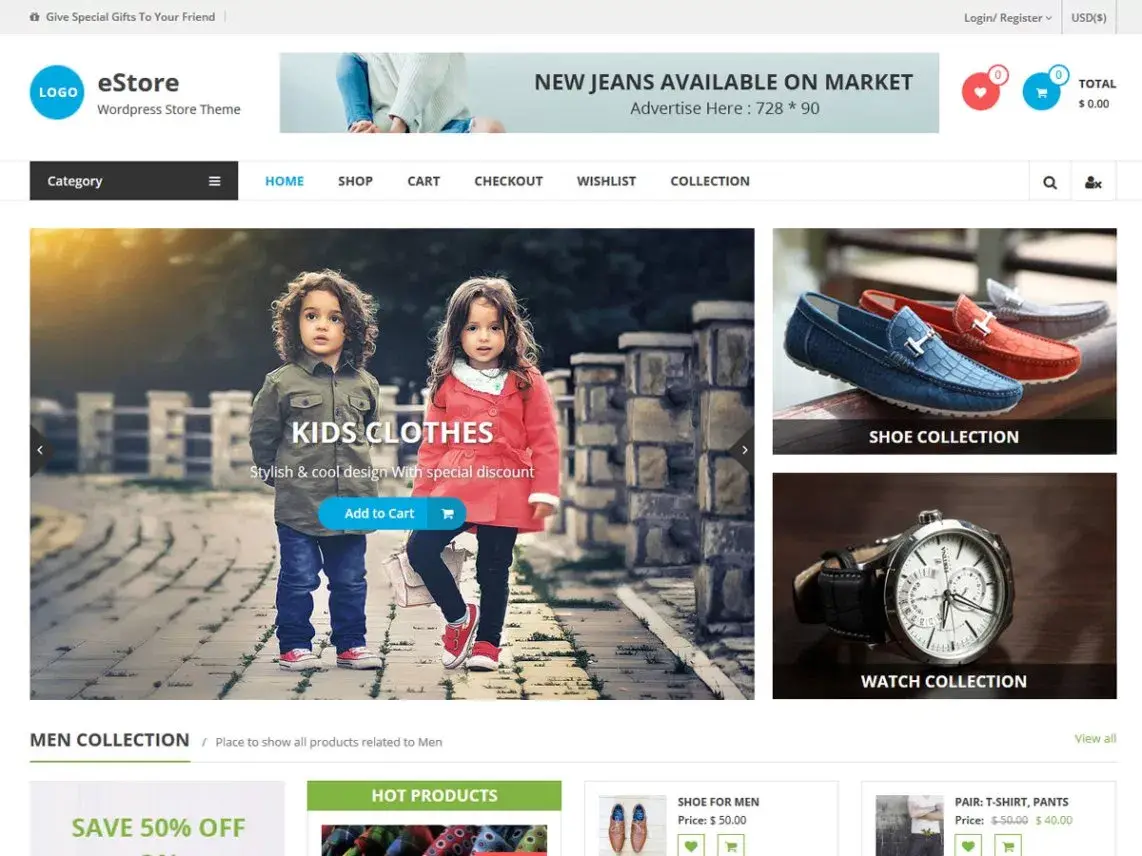
eStore is a free WordPress eCommerce theme that is packed with premium features like custom widgets, attractive sliders, multilingual plugins, and many others.
This template can help you create a professional and well-organized eCommerce shop with a minimum of fuss, although you will need a little WordPress knowledge to get the best out of it.
It is fully compatible with popular eCommerce plugins such as WooCommerce and YITH WooCommerce Wishlist plugins.
eStore has attractive ready-made templates designed keeping the needs of website stores in mind.
Features include:
- Fully compatible with WooCommerce with WC Wishlist.
- Support different colour schemes and fonts.
- Compatible with all major browsers.
- Fully SEO optimized that allows you to follow the best practices.
- Premium option with more features also available.
21. Freesia Empire
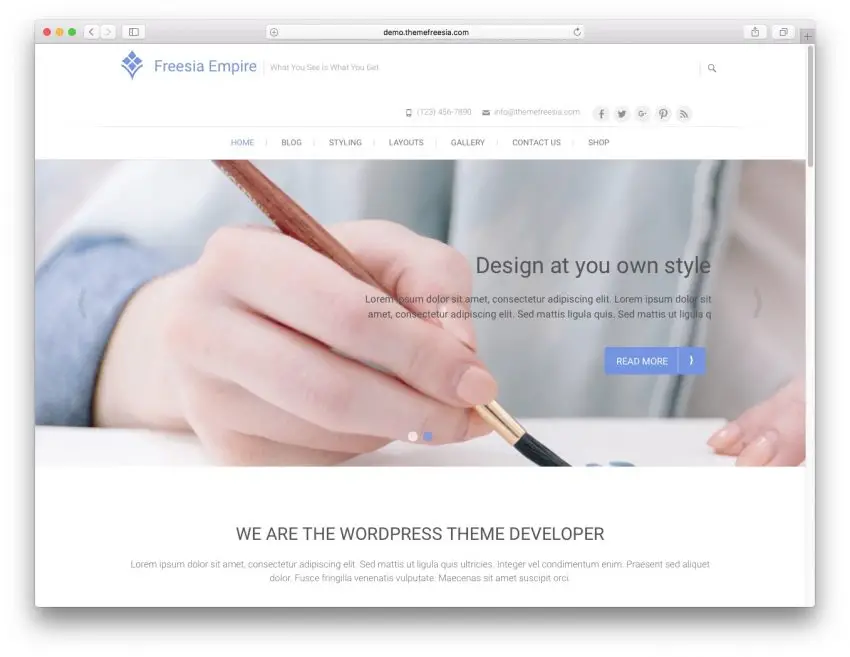
When you offer your audience a fresh and elegant design experience your brand naturally gets a strong presence on the internet. You can give your customers that experience by opting for theFreesia Empire eCommerce WordPress theme.
It is a lightweight, fully-functional template that fits nicely with any kind of eCommerce project. The theme supports plenty of customization options so that you can give your store your own touch. Freesia Empire is fully integrated with popular plugins like WooCommerce, Newsletter, bbPress and others.
Features
- Retina ready.
- Responsive, so automatically adjusts for different screen resolutions.
- Optimized for quick page load time, which means faster page load speed for your site.
- Full customizable page elements for full control.
- Compatible with WooCommerce, Newsletter, bbPress and other plugins.
22. Alpha Store

Alpha Store is a modern free WordPress WooCommerce theme that can fulfil the needs of eCommerce stores no matter your niche. The template supports plenty of layout options that allow users to customize different elements of an online store such as footers, sidebars, menus, fonts, colours and everything that happens on-page.
Alpha Store is fully optimized for search engines and includes SEO features like breadcrumb navigation, meta tag edit, and such. It also loads quickly for extra SEO benefits. Finally, Alpha Store is designed using CSS3 and HTML5 for maximum compatibility.
Features
- Two menu options along with menu positions.
- Supports full-width flexslider carousel.
- Easy social media integration.
- WooCommerce compatibility.
- Cross-browser compatibility.
23. The Styler

The Styler demo is set up as a beauty store or hair salon and works impressively well. It combines dark and light elements to deliver a premium feel while keeping it accessible with lots of whitespace.
The theme has appointment booking build in as well as parallax effects for the pricing block. Simple but effective tricks to increase engagement and minimise your workload.
The Styler also includes attractive service, pricing and store pages, so there really is very little for you to do. Just one reason we like it so much!
Highlights of The Styler:
- Attractive design with upmarket feel
- Parallax effect adds to the vibe
- Includes appealing service, price and store pages
- Has a booking element built into the theme
- Fully compatible with WooCommerce and Elementor
24. Shoppe

Shoppe by Themify is a flexible WordPress eCommerce theme that’s well worth checking out. The full page hero section may not be for everyone but it can be removed in seconds to open up a light, contemporary store page.
Themify has an excellent reputation for creating solid themes and Shoppe is no different. It includes product showcases, category highlights, smart extra information sliders and attractive single product pages.
You can also customise everything you see to brand it to your own needs.
Highlights of Shoppe:
- Modern store layout
- Attractive store pages with nice slider effects
- Pages load quickly even without caching
- Slick checkout page
- Fully responsive and customisable
25. Kereta

Kereta is hosted on the WooCommerce website and is a smart car-based template that could be customized to suit any niche. It’s modern, flat and attractive, with all the ingredients we look for in an eCommerce theme.
The menu is simple and effective, there’s a search option front and centre, a shopping cart and currency selector at the top of every page and a pro-quality layout that looks like any major retailer.
Kereta supports the WordPress full site editor that makes it easy to customise and make your own. It’s also fully responsive and loads fast too.
Highlights of Kereta:
- Looks and feels top quality
- Great use of whitespace and layout
- Top navigation has everything you need and more
- Page sections are well-designed
- All extra pages are equally well-designed
26. Shoptimizer

Shoptimizer is a thoroughly modern WordPress eCommerce template. It has a relaxed feel helped by the calm colours and lots of whitespace. Top navigation is first rate, with search and navigation that’s very easy to use.
The rest of the template unfolds to a nice store page with featured sections, modest but effective animations and support for variation swatches, which is a nice touch.
Shoptimizer is a well-known theme and you can see why. It’s well designed, easy to use and supports the Elementor page builder, which is a great added extra.
Highlights of Shoptimizer:
- Compatible with Elementor and WooCommerce
- Attractive design with nice top navigation
- Subtle animations add to the effect
- Fully responsive and SEO optimised
- Mega menu support
27. Blossom Shop

Blossom Shop is a simple but very effective online store template that lets the products tell the story. Top navigation is as you would expect, with category navigation, search, cart and socials and it all looks very good.
There’s a hero slider and simple product sections that allow product images to shine with minimal distraction. There’s the option to include pricing and reviews underneath to help conversion.
Individual product pages are equally simple and effective. There’s also space for socials, a nice cart page, simple checkout page, a blog and most things a store needs.
Highlights of Blossom Shop:
- Free version is very good, as is the premium option
- Nice minimal design
- Smart single product pages
- Premium version adds lots of extra tools and options
- Great speed test scores
28. Hugo

Hugo opens as a masculine dark theme with a fullscreen hero image before opening up into a much lighter experience. You can change this however you like, but the demo proves it works as light or dark.
This eCommerce theme has an upmarket feel that could work well for a number of niches. Navigation is simple and effective, the image grids all work well and category and single product pages both look the part.
While we would change the brown into something more dynamic, that’s easy thanks to Elementor integration and the ability to customise everything you see.
Highlights of Hugo:
- Very mature theme with an upmarket feel
- Works well as dark or light
- Attractive category and individual product pages
- Supports WooCommerce and WordPress plugins
- Cheap compared to other premium themes
29. Botiga

Botiga from aThemes appears a lot in our reviews because it’s well coded, flexible and delivers exactly what we look for. It comes with 9 readymade eCommerce demos, each with a different look and feel.
Each provides everything an online store needs, a product slider, usable navigation, effective product pages and showcase blocks and store and save for later elements in the top navigation bar.
All pages within all demos work well. We personally wouldn’t choose a hamburger menu for a store but you can change that in seconds using Elementor or the WordPress block editor.
Highlights of Botiga:
- 9 Well-designed eCommerce themes included
- Supports WordPress block editor and Elementor
- Appealing store elements
- Supports product cards that look great
- Multiple customisation options
30. WoodMart
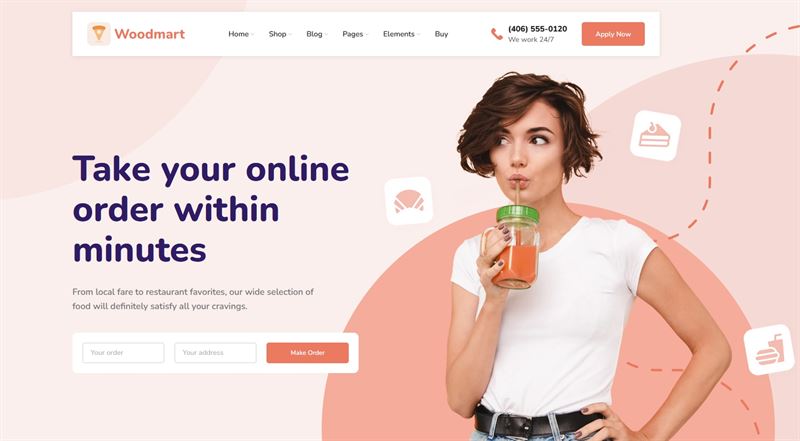
WoodMart could be any store, anywhere. It comes with over 80 readymade demo templates covering every store type. Each has high standards, with great colours, lots of whitespace, logical structures and everything we look for in a store.
All demos include an attractive header area with nice navigation elements, colourful images and headings and all the ingredients a modern store needs.
Most demos include essential extra pages too, category pages, individual product pages and more. Demos also include support for video, audio, countdown timers and a whole lot more.
Highlights of WoodMart:
- Over 80 high quality demos covering every niche
- Colourful designs with some lovely touches
- Store-centric elements relevant to each niche
- Supports WooCommerce, Elementor and the WordPress block editor
- Easy to customise and make your own
31. Deco

Deco is available direct from the WooCommerce website and has a relaxed, Skandi feel that would suit many types of store. It’s a subtle theme with muted images, unfussy navigation and crisp fonts to help create a contemporary vibe.
Demos include hero image sections, featured product areas and nice individual product pages to help sell your wares. It all feels smooth and effortless, which is sure to help conversions.
If you want to shake it up a little, there’s an integrated dark/light colour switcher you can include, or not, as you like.
Highlights of Deco:
- Minimalist eCommerce store theme
- Subtle images and crisp fonts
- Dark/light switcher included
- Block theme that supports FSE
- Supports mega menus
32. Ultra

Ultra is an exceptionally popular WordPress theme. It’s a multipurpose theme with a few store demos built in. While they aren’t the clearest to try in demo form, they do deliver the professional experience we look for in a theme.
The demos cover most industries and would need minimal customisation to make them ideal. As Ultra comes with its own drag and drop page builder, Themify Builder, changing the demo is a piece of cake.
There are tools for changing the header, footer, sidebar, blog layout, scrolling and more, making this a great theme to try.
Highlights of Ultra:
- High quality demos including stores
- Comes with the Themify Builder
- Includes extra options such as counters, maps, countdowns and more
- Fully responsive and SEO friendly
- Compatible with WooCommerce
33. Presence
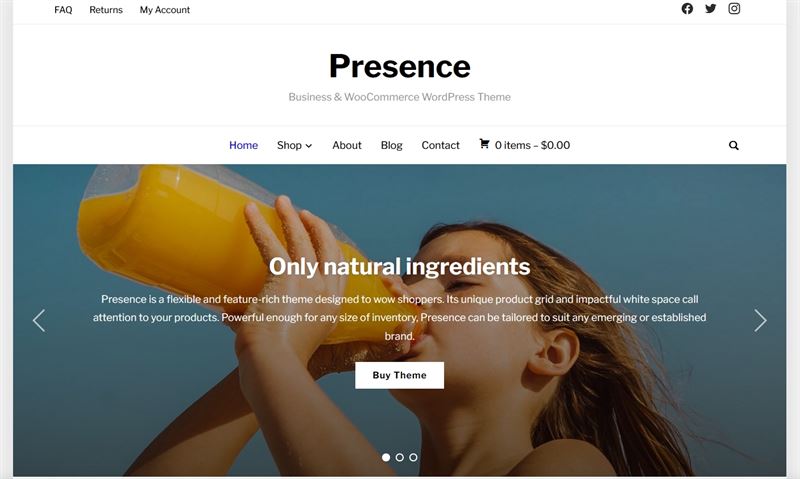
Presence is another decent eCommerce template for WordPress. Unusually, it’s a boxed layout that uses simple lines and unfussy design to create a very relaxed feel. It isn’t Skandi, but it’s not far off, which creates a laid back vibe that could work very well for some stores.
Presence has several demos, some are for stores. Each reflects a similar design philosophy, minimal design done well. There’s plenty on the page to interest a visitor and not so much your products won’t stand out.
Themes are fully responsive, SEO friendly and compatible with WooCommerce and the WordPress block editor.
Highlights of Presence:
- Clean, minimal eCommerce theme
- Boxed design makes an instant impression
- Design allows products to stand out
- Pages load quickly even with images
- Fully responsive and WooCommerce compatible
34. Spencer

Spencer from CSSIgniter has a feminine design that could work for a multitude of store types. The main demo would be ideal for most products as the front page has an upmarket feel without overdoing it.
Demo pages include a readymade store page with an upper navigation bar with shopping cart, language selector and socials. There’s a search function, some nice single product pages and everything you need to build a business around eCommerce.
The theme is compatible with WooCommerce and Elementor and makes it easy to use as is, or turn into something unique.
Highlights of Spencer:
- Well-designed theme with feminine appeal
- Attractive store pages
- Designed to be fast and responsive
- Compatible with Elementor and WooCommerce
- Compatible with most WordPress plugins
35. ProShop

ProShop is a basic WordPress eCommerce theme that’s all the better for its lack of frills. It’s a no-nonsense design available directly from the WooCommerce website and wastes no time in getting down to business.
The homepage is simple and very attractive, with search, category sticky menu with shopping cart and smooth flow down the page. Individual product pages look great and the whole theme offers a slick experience, which is why we like it.
As a child theme of Storefront, the foundations are rock solid and deliver everything a store could need.
Highlights of ProShop:
- Smooth experience throughout
- Simple design done well
- Child theme of the well-coded Storefront template
- Nice, unfussy design
- Attractive single product pages
36. Ecommerce Solution
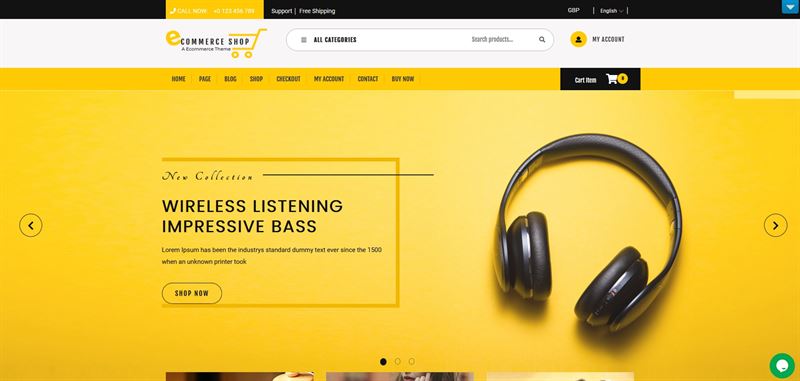
Ecommerce Solution is a free WordPress theme with a premium option. Both deliver a premium experience you wouldn’t be disappointed to see at a big box retailer or brand outlet.
It’s a bold design with a strong image slider and attractive top navigation menu. The demo unfolds to a more relaxed product grid with featured image section, category blocks and lots of effects to draw attention.
Both the free and premium options are viable store themes but paying for it adds a ton of extra design options and optimization tools.
Highlights of Ecommerce Solution:
- Great design with a genuine feel
- Not afraid to make an impact
- Attractive product and feature blocks
- Well-designed top navigation with search
- Smooth flow and fast loading
37. Suffice
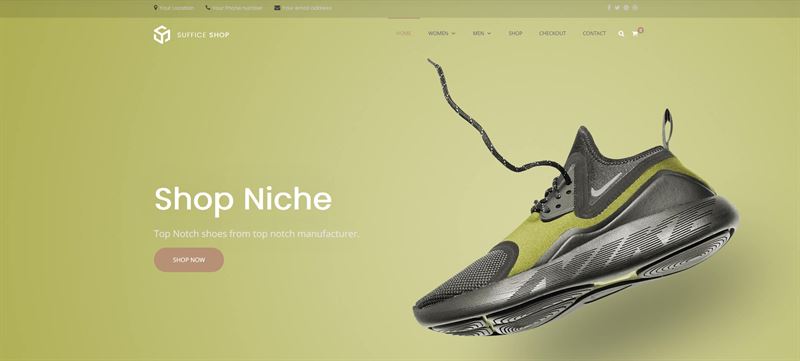
Suffice is a multipurpose WordPress theme with a couple of very nice eCommerce demos. The Suffice Pro Shop demo is where it’s at. It offers everything a store could need with attractive designs, lots of eCommerce blocks and a very effective mega menu with product images.
It is compatible with Elementor, Beaver Builder, the WordPress block editor, WooCommerce and most WordPress plugins. The free version loads quickly while premium includes the store template and more design tools.
As it was designed by ThemeGrill, you’ll also get to enjoy clean code and a stable design with full support should you need it.
Highlights of Suffice:
- Multipurpose WordPress theme with eCommerce design
- Compatible with page builders and WooCommerce
- Nice design with some neat touches
- ThemeGrill has a great reputation
- Fully responsive and SEO friendly
38. Mesmerize
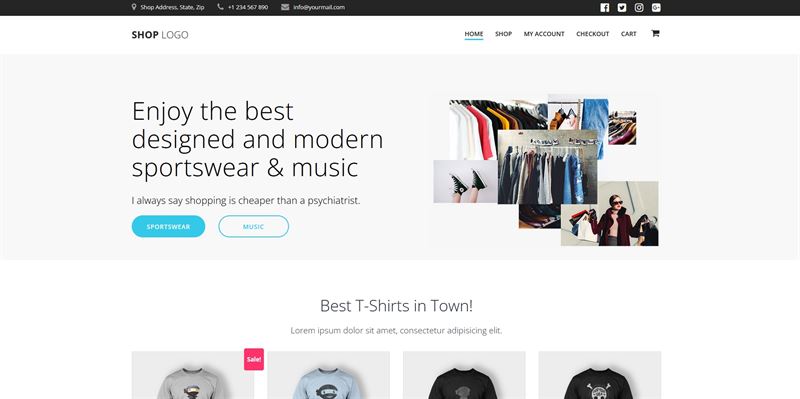
Mesmerize is a modern eCommerce theme with a free and a premium version. You’ll need to buy premium to access all the customization tools, but the eStore theme is free.
The design is simple and we regard it as a child theme from which you can add your own flourishes using the WordPress block editor. The theme comes with a number of blocks you can add to any page to help sell or nurture customers.
This is a feature-rich theme with everything you need to build an online store. It will take imagination but you really could create something unique.
Highlights of Mesmerize:
- Simple but effective eCommerce theme
- Free and premium version
- Lots of blocks and customization tools
- Loads quickly even with lots of images
- Compatible with WordPress block editor and WooCommerce
39. Løge
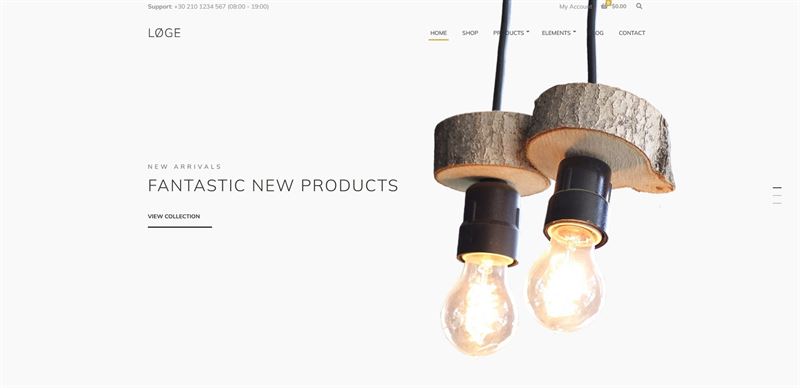
Løge is a minimal WordPress eCommerce theme that lets product images stand out. It’s a very slick theme with a premium feel and could be ideal for a wide range of stores.
The default demo opens with a frameless product slider with a smooth transition that captures attention. The rest of the theme uses minimal structure to let the product blocks stand out, as do the individual product pages.
As Løge is a CSSIgniter theme, it is well coded and performs well. You also get Elementor and WooCommerce compatibility as part of the package.
Highlights of Løge:
- Nice minimal design that works well
- Products can really stand out on the page
- Individual product pages are particularly good
- Full compatibility with Elementor and WooCommerce
- Use it on unlimited websites
40. Shopstar!

Shopstar! Is a largely monochrome store theme that lets the product images add pops of colour. It’s a tried and tested way to help products stand out and grab attention and this theme does it well.
There’s a free and a premium version of the theme, with premium adding more customization tools and features. The core theme may seem a little plain, but with an array of colourful product images, it will soon come alive.
Shopstar! Is compatible with Elementor, WooCommerce and most WordPress plugins. Whatever type of store you want to create, you can do it with this theme.
Highlights of Shopstar!:
- Mostly monochrome design that lets products shine
- Simple structure that’s very effective
- Free and premium versions
- Compatible with Elementor and WooCommerce
IMH
Do you want a fast website?
Who am I kidding? Don't we all?
So why do so many of us struggle?
The biggest challenge is usually finding a fast, reliable hosting company.
We've all been through the nightmares - support take takes forever or doesn't resolve our problem always blaming something on your side...
But the biggest bummer is that the website always feels slow.
At CollectiveRay we host with InMotion hosting and our website is stupid fast. We run on a custom stack of LightSpeed server setup on MariaDB with a PHP7.4 engine and fronted through Cloudflare.
Combined with our front-end optimizations we reliably server 6000 users every single day, with peaks of 50+ simultaneous users.
Want to get a fast setup like ours? Transfer your site for free to InMotion hosting and get our 50% OFF on current pricing.
Try InMotion Hosting with 50% OFF for CollectiveRay visitors in April 2024 ONLY!
Free vs Premium WordPress eCommerce Themes
As you can see, there are some top quality free and premium WordPress eCommerce templates around right now. But what’s the difference and what should you go for?
Free eCommerce WordPress Themes
Free WordPress themes can be found on the WordPress.org Themes directory.
Their main advantage is obviously the price. Nobody can argue with the value of free and that is the main attraction with this kind of theme.
Unlike many other types of free product, the standard of most free WordPress themes is high. If you’re worried about using an inferior product, don’t be.
Read reviews, test the theme on a non-live site first and experiment a little. You will lose nothing but a little time and effort if it doesn’t work.
The main downside of free WordPress themes is that they are usually nowhere near as feature-rich as premium themes.
Developers either offer free themes to get you interested in the premium option or convert a once premium theme to free once it’s profitable life has expired.
That doesn’t mean the theme won’t work, far from it. All free themes on WordPress.org are fully functional.
It does mean there won’t be much support and you will need some WordPress, CSS and HTML knowledge to customize the theme to your needs.
If you can do that, or learn to do that, free WordPress eCommerce templates are a very viable option.
Premium eCommerce WordPress Themes

Premium WordPress themes are exactly that. They come at a price premium. Prices are usually sensible and will either be paid annually to keep receiving updates and support or a one-off fee that may or may not contain regular updates.
Almost all premium themes will have some kind of support. Some developers offer tiered services, so cheaper versions get email support while more expensive versions get live or priority support.
Premium WordPress themes will also be the latest themes using the latest design trends. They will be a showcase of the developer’s work and will include the widest range of plugins, features, and options. You may also get access to a wider range of readymade templates.
The premium templates we feature on this page all come with access to dozens of preconfigured templates that are ready to go. You can also customize these templates as much, or as little as you need to fit it into your brand.
Another benefit of premium themes is they are more unique. They are still sold en masse but they are not as numerous as free templates.
They usually also include page builders such as WPBakery, Elementor, Divi, Beaver Builder or one of the numerous others out there.
This provides simple drag and drop functionality that opens up the theme to almost infinite customization. So even if the template you buy has sold many thousands, you can still make yours unique.
Using a Theme - Free vs Premium
Both free and premium WordPress templates have their pros and cons and there is no ‘best’ option. It depends entirely on your needs and whether you can afford a premium template or know how to code or not.

If you can code, you can better tweak a free theme to your needs. You will also be more likely to be able to troubleshoot compatibility or stability issues yourself.
If you have an eye for design, you can also create a template of an equal quality to a premium theme.
If you cannot code or have no real eye for design, a premium theme comes into its own. Developers have done the hard work for you and have created a range of attractive templates for you to use.
They will also come with plugins, often built-in, come with some kind of support and perhaps even documentation or video tutorials.
Choosing a WordPress theme is like any purchase.
Take a good look at what is available in the market, compare different options, check reviews, look at real-life examples of the theme in use on the internet if possible and decide if the theme is right for you.
Also, make sure the template is compatible with WooCommerce and any specific plugins you want to use.
Ensure it has been coded to load quickly, is compatible with WPML if at all possible. It also has to be responsive. The more mobile-friendly your online store is, the more likely it is to deliver a profit.
Setting Up Your Online Store
eCommerce is huge.
If you read eCommerce in numbers at the beginning of this post, you will already know that it is worth billions across the world and is expected to keep growing.
While there is still a place for brick and mortar stores, retail is steadily shifting more to online.
That means competition in the marketplace is rife. Thousands of other people will be trying to outsell you, outperform you and outrank you in search engines.
Any venture you launch has to be planned perfectly in order to survive. That’s what this part of the guide is about.
We are going to walk you through the entire process of setting up an online store. We will cover:
- Selecting a niche.
- Selecting products to sell.
- Planning and setting up the business.
- Setting up your eCommerce website.
- Running and maintaining your online store.
- Tips for running a successful eCommerce store.
1. Selecting a niche
Selecting a niche is about deciding what kind of online store you want to run and what products you want to sell. You may already know this. If you do, you’re one of the lucky ones.
Few individuals venture into eCommerce knowing exactly what they want to see. Fewer still have a product already in place or even in mind when deciding to launch an online store!

We always suggest selecting an industry or niche you already know or have interest in. Few people that go purely for the most profitable last very long.
If you’re going to be spending hours a day managing your online store, you had better be enthusiastic about it otherwise you’re not going to be able to sustain the effort required.
Consider your hobbies and interests. Is there an opportunity there? Is there a commercial opportunity for something you have always wanted to get into? How about something new that you have always wanted to try?
Then consider how people might buy what you are considering selling. Does it lend itself to online?
For example, selling trainers (sneakers) is great for online but many buyers like to try them on first.
This would mean either lower sales because brick and mortar allow buyers to try shoes on or more refunds as people will buy the product, try them and return them if they don’t fit or don’t like them.
How could you compete in this niche? Could you handle constant returns as people bought shoes to try and then returned them? If yes, the niche could be for you. If not, you may be better looking elsewhere.
There is a lot more to consider when selecting a niche than stocking products that have a high-profit margin!
Your next consideration is customer retention. Do you want to sell big-ticket items that few customers will come back for or cheaper, more disposable items for repeat custom?
Wedding products are a classic example of this. There is a huge profit margin in most wedding products. However, weddings should be a once in a lifetime event so customer loyalty would be minimal.
Whereas, selling headphones, shaving products, makeup or other everyday items is the opposite.
There is modest per-unit profitability but a huge opportunity for repeat custom. These are often referred to as commoditized products. Those that are in high demand but offer lower profit per unit.
If you cannot think of a product to sell, consider something that solves a particular problem.
Do you or family or friends often complain that a product doesn’t do something? That there doesn’t seem to be a product to solve a specific problem or address a particular need?
Which leads us nicely onto…

2. Selecting products to sell
Selecting products to sell will depend on the niche you choose and the type of business you want to run. Some of you have the luxury of making your own products and selling them. If so, you’re still one of the lucky few.
For the rest of us, we have to combine the industry we choose with the products we sell to compete in our market.
There are a ton of questions around product selection. Do you go cheap and high turnover, premium and lower turnover with more per unit profit?
Do you make your own products? Stock your own products or dropship them? Depend on high-profit one-off purchases or lower profit repeatable purchases? Do you latch onto trends and change quickly or stick to established products that are less susceptible to trends?
You may already know the answer to these questions but if you don’t, now is the time to consider all the factors.
Once you have an idea or two, it’s time to perform some research. You need to answer some key questions, such as:
- How large is the target market for your product?
- What price can the market sustain for that product?
- Big-ticket or more frequent purchases?
- How will the product and target market evolve over the next 5 years?
- How much competition is out there in your niche?
- How effectively could you compete with that competition?
- Are there any impending legal or societal changes that might impact your product choice?
- Can you compete on price or convenience?
- What is the return/refund potential of your products? Will you be able to handle the volume?
- Can your niche scale-up?
- Does it support diversification?
- What problems does your target market have which you could solve with a product or service?
- What key values would your audience want to see to increase loyalty?
I’m sure there are dozens of other questions you can think of but you get the idea.
It’s all very well deciding in isolation what products you want to feature on your eCommerce store but the market needs to agree with you for you to survive.
You may have a unique passion in life or skill to create bespoke products but if there isn’t an appetite for them, you have to reconsider.
Ask as many people as you can during market research. Make sure some of them are strangers or friends and family know that it is essential to be completely honest.
Dropship or stock?
When you have an idea of what products you want to sell, you can decide whether you’re going to buy them and store them yourself or use a dropshipper.

Dropshippers are companies that either manufacture the products and ship them directly to customers on your behalf or are distribution companies who buy in bulk and will distribute for you.
Dropshipping used to be problematic but the rise in eCommerce has brought some very reliable operators into the market.
Both options have pros and cons.
Stocking your own products requires a significant financial outlay to buy the products. It also requires secure storage to keep them safe and the ability to fulfil orders quickly and efficiently.
It also means you handle your own returns and refunds, which can add to your workload.
Dropshipping needs none of that. However, you have much less control over fulfilment and delivery. Essentially, you depend on the dropshipper picking and packing in an accurate and timely manner in order to get the product to the customer.
Returns and refunds can take longer and some dropshippers have shady return policies. Make sure you know what you’re signing up to!
Like many decisions in eCommerce, there is no ‘right’ answer. Only the answer that works for you in your particular situation.
This page over at Big Commerce goes into great depth about product selection. It is well worth a read.
3. Planning and setting up the business
So far, all our work to set up our eCommerce store has been theoretical. Brainstorming, planning and researching all have a part to play in setting up a business but it isn’t the most fun you can have.
We still have a little more planning to do before we get to the good stuff though!

You will be delighted to know that planning a business setup is much, much easier than deciding what to sell in your store.
- You need to come up with a business name.
- Decide on a business formation.
- Register your business with the relevant authorities.
- Secure the domain for your business name.
- Set up a bank or payment account in the business name.
- Get some kind of insurance for the business.
Come up with a business name
Let us get the toughest part of this exercise out of the way first shall we? Coming up with a business name has to be the toughest task you will do in this phase.
You may be lucky and already know what to call your business. If you’re like the majority of newcomers to eCommerce, you’re going to have to decide now.
Your name needs to be:
- Original – It stands to reason that you need a unique name for your business. Something that stands out and doesn’t confuse consumers.
- User-friendly – Your chosen name needs to be easy to say and to type, especially on mobile. It should avoid hyphens and special characters where at all possible.
- Available as both a business and domain – Your chosen name has to be able to be registered with the local authorities so cannot be the same as an existing business. It also needs to have the TLD available (.com, .org, .co.uk, etc.).
- Sharable – Shareability is essential. While it could come under being user-friendly, having a sharable name is so important we are listing it all on its own.
Use the Shopify business name generator if you’re stuck or read this great piece on business naming if you need more help.
Decide on a business formation
Depending on where in the world you live, you will have several company formation options open to you.
Examples include sole trader, Limited Company, LLC, partnership, corporation, cooperative and perhaps others.

We cannot offer much advice here as the structure of your business is dependent on your location and your personal and financial situation.
We can say that it requires as much research as you are willing to do.
It is also one of those tasks where paying an accountant or lawyer for professional advice could very quickly pay for itself.
Register your business with the relevant authorities
Once you have the name and ideal formation for your company, now is the time to register it.
Do so with your local or regional authorities as quickly as possible to make sure someone doesn’t steal the name after you spent so long coming up with it.
Like company formations, business registration will differ depending on where in the world you live. There are companies that can perform all the administration for you and set up a company in your name in your country for a modest fee.
It may be worth researching those and have them perform the registration so you don’t have to.
Secure the domain for your business name
The domain is the website name of your store. For example, our domain name is www.CollectiveRay.com.
You should ideally secure the domain for your business the moment you decide on a name and have made sure it will be acceptable with your local business authorities.
The faster you do this, the less chance the name will have been taken since you last checked.
Find a web host you want to work with and secure the domain. Make sure your primary domain is a TLD (Top Level Domain).
This is for trust and authority. Internet users trust .com, .co.uk, .org, .net and so on as they have been established the longest time.

During your research, you should have identified that your name is available, so secure it now. Buy it immediately as competition for domain names is almost as hot as for eCommerce.
You can optionally add a different domain name too if you like. There are now hundreds to choose from and include everything from .ninja to .store.
If you have your eye on a boutique name, you can point it to your TLD domain so customers have the option of using either or. This is the only way we would suggest using a name like this.
Buy your domain and hosting together for ease of use. You will need that hosting later.
Set up a bank or payment account in the business name
Once you have your business registered and have received a company number and documentation, you can set up a bank account.
You will have to prepare accounts for your store to remain legal and using a separate business account keeps things nice and tidy.
Business bank accounts will also open up lines of credit and help build the credit score of the business. This could come in useful in the future should you require a loan or other finance.
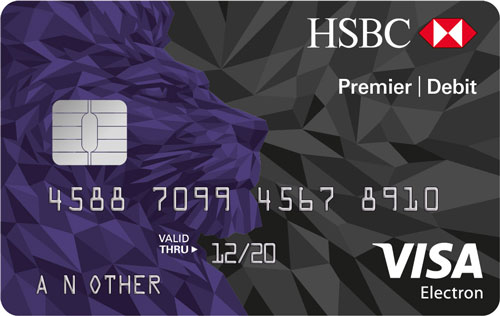
Insurance for eCommerce
Insurance for eCommerce is so often overlooked when people are enthusiastically setting up their online store and new business. Insurance is essential in any retail business as it protects you against loss.
Insurance should cover loss of stock, accidental damage, claims from third parties, claims from dissatisfied customers and perhaps business interruption.
It is well worth considering eCommerce insurance, especially if you live somewhere that regards litigation as the norm.
4. Setting up your eCommerce website
You have a couple of options when setting up an eCommerce website. You could go the hosted route and use Shopify, BigCommerce, Squarespace or one of the many other solutions.
Or you could self-host with your own WordPress website.
As we have spent the last 7,000 words or so promoting WordPress and WordPress eCommerce themes, let’s assume you want to set up and manage your own website rather than use a hosted one.
You will need:
- A web hosting package compatible with WordPress. We would highly recommend our host InMotion Hosting, or check out our WooCommerce hosting recommendations here.
- A copy of WordPress if your host doesn’t have an installer.
- An eCommerce theme and any required plugins.
- Good quality images and descriptions for your products.
We suggest preparing everything you need in advance so you can begin the build without having to be interrupted.

Installing your store
Many web hosts will include an app installer with their hosting packages. They are often marketed as automatic app installers.
Softalicious is an example of an app installer that can automatically set up WordPress on your host. This saves a lot of time and effort so if at all possible, select a web host that uses an app installer like this.
You will also need the theme you want to install onto WordPress. If you have selected one of the themes on this page, you will have a download package in a zip file. You’ll need this in a little while.
Check this downloaded file. Open it so you can see inside. If you see many levels of folders before you get to the theme file, decompress the layers until you are left with the WordPress theme file still zipped.
You should see THEMENAME.zip. It is this file you will upload to WordPress.
While not mandatory, we suggest preparing all product images and copy in advance. When you’re in the middle of building pages and have a good flow, the last thing you’re going to want to do is keep stopping to prepare product pages.
Having everything ready means you will just have to copy and paste the descriptions onto your pages.
The basic eCommerce website setup goes a bit like this:
- Log into your web host with the provided login.
- Select the app installer if there is one and install WordPress.
- Load the WordPress Dashboard and select Appearance in the left menu.
- Select Themes and Add New on the next page.
- Select Upload Theme and Choose File.
- Select the THEMENAME.zip file containing your theme.
- Select Install Now and wait for WordPress to upload and install.
- Select Activate when you have the option.
- Load any required plugins if the theme requires them.
- Load any extra plugins you might want to use.
That’s the basic setup process for WordPress.
Different themes will have different dependencies. Those built around WooCommerce will either come with the plugin already or require you to add it. Most will have a simple single click installer for these.
Building your store
Now it’s time to set up some pages. You will need a main page to act as your Homepage, an About page, a Contact Us page, a Privacy page, Terms and Conditions page and your product pages.
Some regions mandate the use of privacy and terms and conditions pages so make sure you comply with your local regulations.
If your theme comes with a page builder, you can use that to build pages. If it has included themes, there will often be a one-click installer.
Select the template you want to load and allow the theme time to load the template and any demo data. You can then replace the demo data with your own during page configuration.
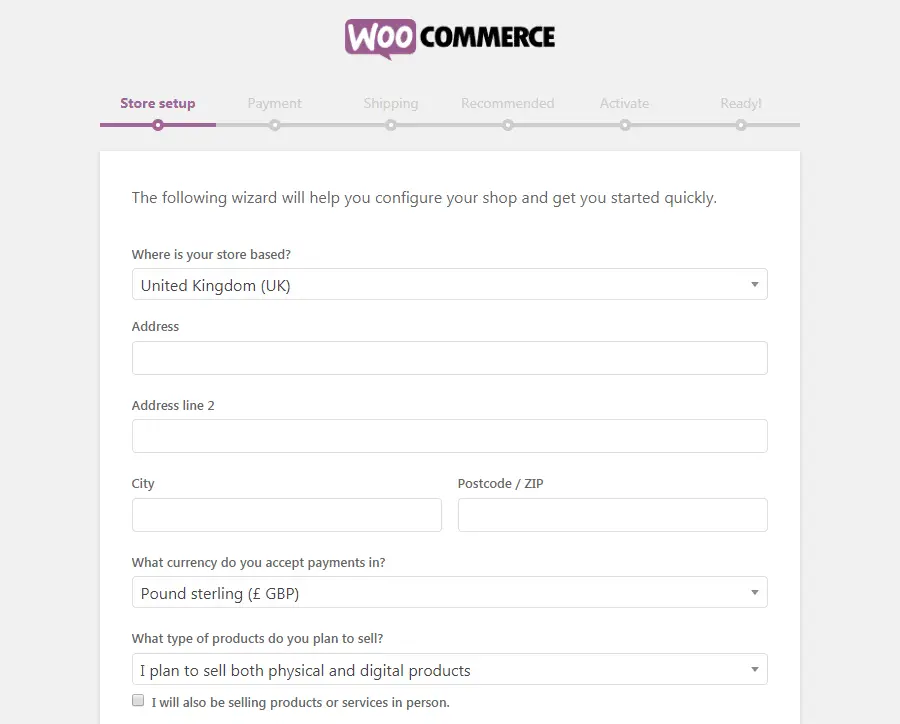
Once you have the basic site layout done, you can set up product categories and begin creating product pages.
If you’re using WooCommerce, the plugin has tools for creating product pages. This guide has a complete breakdown of setting up WooCommerce so we won’t repeat it all here.
If you’re using something else, you may have to create your own. Some themes allow you to create template pages so you don’t have to laboriously create each page on its own.
There are also WordPress plugins that can duplicate pages to make site building much, much faster.
Create a single product page and customize it until you are completely happy. Save the page and then use a plugin to duplicate that page as many times as you have products.
Do this for every product in every category until your website is fully finished.
Configuring your store
Now you have the framework of your online store, you will need to perform some final configuration.
Exactly what you have to configure depends on whether you use WooCommerce or another eCommerce plugin.
You will need to:
- Set up payment options.
- List shipping options.
- Ensure all your terms and conditions are linked and clear.
- Provide feedback and communication options.
- Install security plugins.
How much or how little of this you need to do and how you do it depends on what eCommerce plugin you use.
WooCommerce includes most of these as part of the initial setup. Other plugins will likely do the same. Just make sure your bases are covered before you launch.
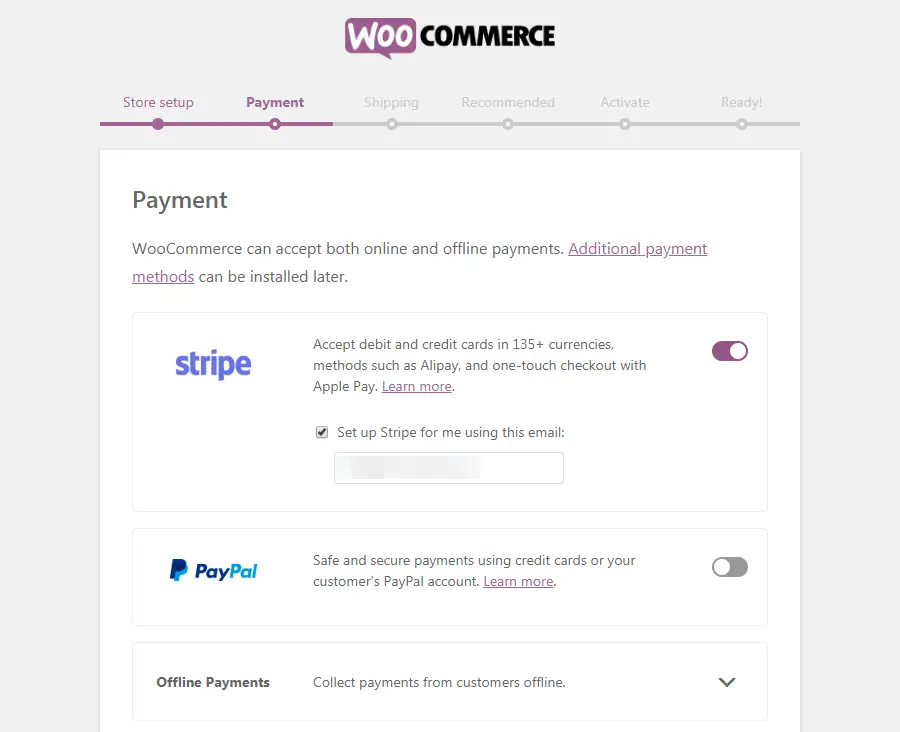
Setting up a payment option in WooCommerce is actually very straightforward.
- Select WooCommerce and Settings from the left menu in your WordPress dashboard.
- Set your address from the General tab and save changes.
- Select the Payments tab at the top.
- Enable the various payment methods on the page using the toggle.
- Select Set Up to the right of each payment method to configure it.
- Work your way through each payment method until complete.
The Set Up button to the right leads you to another screen where you will enter the relevant information for the payment method. This would be your business bank account details, PayPal email address or credit card merchant data.
Once done, the payment options you enable will appear on every product page.
You will then have to configure currency, shipping, tax and other relevant settings but you get the idea.
Securing your store
WordPress is now fairly secure as a CMS but it could do better. As you are dealing with money and people’s data, you have a responsibility to manage that accordingly.
This page has an in-depth look at security plugins for WordPress with some ideas on what you need to do and how you go about it.
While aimed at American stores, the majority of the advice on the page is relevant everywhere. Check your regional rules and regulations to make sure your store is compliant. Fines can be substantial if you’re not!
5. Running and maintaining your online store
Running and maintaining an online store can be a full-time job. It won’t be to begin with but be prepared to spend a lot of time managing your store and making sure everything works.
Here we are talking specifically about the store itself and not stock, shipping, fulfilling orders and customer services.
There are several areas you should be prepared for when running your store. This is especially true when running a self-hosted store which is what we are doing here.
You will need to spend time:
Running backups – Run regular backups and make sure a copy is stored locally on your web host and a copy is downloaded to the cloud or your computer.
Checking pages and links – There are automated link checker tools for WordPress or you can perform this task manually. You will need to regularly check pages for broken links and missing images as these can impact the customer experience.
Set up downtime alerts – Your web host might offer downtime monitoring or you can use JetPack or another WordPress tool to alert you to downtime. As downtime impacts profitability, this is definitely something you need to consider.
Checking your store on different devices using different browsers – While CSS and HTML standards are supposed to minimize issues between browsers, they have yet to eliminate them altogether. Checking your store regularly to ensure a WordPress or theme update hasn’t broken your site is another essential.
Checking your social media channels – If you’re using social media for marketing, and you should, you need to set aside time each day to respond to people. Social media is a two-way conversation and the more time and effort you invest, the higher the return.
Checking emails and site feedback – Every retail business will field emails and calls from customers. The majority will be dumb questions shoppers are too lazy to figure out themselves. It may sound harsh, but take it from us, the majority of your interaction with customers will be mundane stuff. That said, any customer interaction is important so treat it as such however hard it might be!
Offering support – Some queries and communications will be more important such as customer service and support. Make sure to prioritize these communications above all else. A true measure of a company is how it deals with complaints, criticism and issues. Handle them well and you gain a loyal customer. Handle them badly and word travels fast.
Those are just some of the tasks you need to be prepared to perform on a regular basis when running an online store.
That’s not even touching the actual retail and product side of the business!
6 Tips for Running a Successful eCommerce Store
Now you have set up and launched your online store and have an idea of what running an eCommerce empire looks like, let us share some of the things we have learned over the years to help you succeed.
You can take or leave these tips as you see fit but all of them have been learned over almost a decade of experience.
Keep product pages simple
It is often tempting to fill product pages with everything the buyer needs to know in the hope they purchase.
This can be a mistake. The more you put on the page, the more distracted buyers can be. A simple product page works well.

Use a good quality image in immediate view. A features and benefits bullet section, a brief outline and a call to action. Further down the page you can add your product description to help the buyer make a decision.
Keep specifications and technical data for below the fold.
If you’re using reviews, have a link to reviews with a star or scoring system at the top but have the full reviews below the fold. Look at some of the leading retailers for inspiration for your page layouts.
Organization is key
As your store grows, organizing your products is going to become very important. Keeping navigation as simple as possible shortens the path from arrival to purchase.
The easier and more logical you make it, the more profitable you should be.
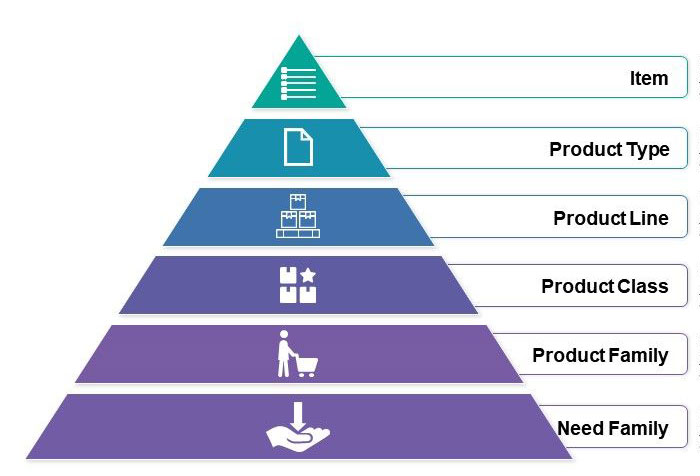
Look at your key competitors or leading online retailers. Look at how they structure their products. Does it work? Could you improve on it? Take what you learn here and use it on your own site.
Always have a search function
As logical as your navigation might be, you should always have a search function front and centre too. You want to appeal to as many types of visitor as possible.
Some will be happy using your navigation while others will just want to search for the product directly.
Make sure to cater to both.
Include the upsell
Notice how retailers like Amazon will have showreels down a page displaying products like the one you’re viewing?
Do the same. There are specific plugins you can use to highlight featured products or include ‘Shoppers who bought X also bought Y’.
Use one or two on each product page and use one on the checkout page before order confirmation. They can be an important way of making extra sales.
Make checkout simple
How many times have you abandoned an online shopping cart because there were too many steps or you were forced to create an account before purchase? We have done it lots of times.
Take another leaf out of leading retailers’ books and keep the path to purchase as short and as slick as possible.
Confirm the order, take the shipping address, take payment and say thank you. The shorter and easier you make the purchase, the lower cart abandonment you should see.
Encourage account signup but don’t force it
Taking the previous point further, offer the buyer the opportunity to sign up for an account but don’t make it mandatory.
People are far more likely to open an account in return for discounts, early access to products or sale items or other inducement than if you force them.
Use FOMO to your advantage. Offer exclusivity or something compelling to encourage signup. You could even use convenience like Amazon does.
Notice that One-click Checkout is only available to account holders?
This isn’t just because of the mechanics of it but also to encourage guest purchasers to sign up.

Set up abandonment emails
Shopping cart abandonment is inevitable in eCommerce but you don’t have to sigh and then forget about it. Set up a system of email alerts for abandoned carts.
You don’t know why the purchaser abandoned their cart so a gentle reminder that the product they were about to buy is still in stock, has limited availability or is about to go out of sale could clinch that purchase.
WooCommerce has a facility for follow up emails so utilize it to send abandoned cart emails to account holders. It doesn’t take long and could reduce some of those lost sales.
Offer free shipping
A leading cause of abandoned shopping carts is unexpected costs at checkout. While shipping isn’t exactly unexpected, it is a prime reason people abandon.
Avoid this by offering free shipping and make it clear across your store that shipping is free.
Add the cost of shipping onto the product price to make sure you don’t lose out but don’t add shipping if you can avoid it.
Even giants like Amazon suffer cart abandonment because of shipping charges.
Include reviews and testimonials

Reviews and testimonials are now mandatory for online stores. Also known as social proof, reviews are an essential part of the customer journey.
They are evidence that your marketing is telling the truth, that customers can rely on your product for quality and to deliver the benefits it promises.
No online store will sell much without some kind of review system in place. According to studies, 63% of consumers are more likely to purchase if there are reviews on a page.
You can use a plugin to set up a review system such as WooCommerce Product Reviews or other service. However you integrate reviews, make sure to use them.
Have a blog
Blogging is not only useful for SEO, it gives someone a reason to visit your online store other than to buy.
People won’t visit your store every day to buy something but they would if you had an interesting blog.
A blog gives you the chance to engage your customers, offer insight, value and entertainment. Include product reviews and features, upcoming products, examples of your products in daily use, case studies of how products have helped people or could be used to help people.
Keep the content coming and readers will keep coming too.
Build an email list
Opt-in email lists are marketing gold. They are an opportunity for you to reach out to customers, showcase new products, alert them to sales or specials and generally keep them in the loop.

Always include a newsletter signup option in your online store. Offer an inducement like early access to sales or the like and emphasize that you won’t spam or share the email. Have it alongside the account option, not as part of it to widen appeal.
Then make sure every time you contact your email list, you are offering genuine value or something useful.
Don’t spam them with pointless stuff, don’t email them too often and you should gradually build a loyal customer base.
Make sure you are contactable
Offer as many ways as possible to be contacted through your store.
Offer email, live chat, telephone, SMS, chat app or whatever fits your lifestyle. Just make sure customers can contact you when they need you.
You can use a Unified Communications solution to divert all queries to your phone or set up a dedicated desk.
Use a WordPress chat plugin or something completely different. However you do it, make sure you are contactable and answer all queries in a timely manner.
WordPress eCommerce Themes FAQs
Can WordPress be used for eCommerce?
WordPress can be used for eCommerce. Plugins like WooCommerce make setting up an online store as simple as possible. While it takes more work to set up than Shopify or Squarespace it can be much cheaper in the long run and gives you complete control over how your online store looks, feels and operates. Using WordPress for eCommerce also opens up the entire WordPress theme ecosystem for you to use rather than the finite options with a purpose-built eCommerce solution.
How much is a WordPress eCommerce site?
A WordPress eCommerce site can be very cost effective. You will need a domain, hosting, a WordPress theme, the WooCommerce plugin or other eCommerce system and products to sell. We would suggest that initial setup would cost around £200/€220/$250 to start. That could increase depending on the cost of the WordPress theme you select and whether you use premium plugins or services to help run your store. Hiring a WordPress developer to set everything up could easily double that initial budget but is an option if you cannot do it yourself.
What is the best eCommerce plugin for WordPress?
We talk a lot about the WooCommerce WordPress eCommerce plugin in this piece. That is because it is very good and because we have more experience with it than other plugins. There are others available such as BigCommerce, Easy Digital Downloads, Cart66 Cloud, WP eCommerce and others. Each eCommerce plugin has its strengths and weaknesses so you will need to explore each of them if you want to use the best one for your particular store.
Is WordPress really free?
Yes, WordPress really is free. The core CMS is free and open source. Many of the templates featured in this piece are also free. Many thousands of plugins are also completely free. You will need to pay for a domain, hosting and perhaps a premium theme or plugin but WordPress itself is completely free of charge.
How much does WooCommerce cost?
How much WooCommerce costs depends on what you want to do with it. The core plugin is free. You can use it to create the vast majority of your online store and get it up and running without paying anything. WooCommerce has a selection of premium templates and plugins that offer particular features which cost money. A WooCommerce theme can cost between $39.99 and $79.99, while a WooCommerce plugin costs between $49.99 and $199.99 depending on what it is.
Which is better: Shopify or WordPress?
Asking whether Shopify or WordPress is best depends entirely on what you want from it. WordPress is huge, has a massive user base, thousands of eCommerce themes and plugins and powers almost half the internet. You will need to set your store up yourself or pay for someone to do it though. Shopify is a closed system that takes the work out of setting up your online store but you pay a higher monthly fee for the privilege. There are fewer themes and plugins but hosting and support is all taken care of for you.
Which is best theme for eCommerce in WordPress?
Divi is the best WordPress theme overall acording to us. But if you're looking for an eCommerce specific WP theme, we would suggest Flatsome as one of the top options. It is a well-rounded theme which is focused on online shops at a relatively good price.
Which WordPress eCommerce themes do you prefer?
In the 25 Best WordPress eCommerce themes for online stores, we have shown 15 top flight premium themes and 10 free eCommerce themes. We have also walked you through the entire setup process for your online store from beginning to end. Each of those themes has been carefully selected and tested for quality, reliability and usability. Each has different qualities and characteristics and would work well in a wide range of niches.
What all have in common is accessibility, beauty and compatibility. No matter what kind of store you’re setting up, no matter what product you are selling, one or more templates in this list delivers.
But are there any others which you prefer? Are there some astounding WordPress eCommerce themes you think should have been featured here? Let us know in the comments below if you do.
Please leave a useful comment with your thoughts, then share this on your Facebook group(s) who would find this useful and let's reap the benefits together. Thank you for sharing and being nice!
Disclosure: This page may contain links to external sites for products which we love and wholeheartedly recommend. If you buy products we suggest, we may earn a referral fee. Such fees do not influence our recommendations and we do not accept payments for positive reviews.

